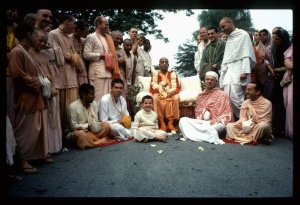CC Madhya 6.160 (1975): Difference between revisions
(Vanibot #0027: CCMirror - Mirror CC's 1996 edition to form a basis for 1975) |
(Vanibot #0020: VersionCompareLinker - added a link to the Version Compare feature) |
||
| Line 2: | Line 2: | ||
<div style="float:left">'''[[Sri Caitanya-caritamrta (1975)|Śrī Caitanya-caritāmṛta (1975)]] - [[CC Madhya (1975)|Madhya-līlā]] - [[CC Madhya 6 (1975)|Chapter 6: The Liberation of Sārvabhauma Bhaṭṭācārya]]'''</div> | <div style="float:left">'''[[Sri Caitanya-caritamrta (1975)|Śrī Caitanya-caritāmṛta (1975)]] - [[CC Madhya (1975)|Madhya-līlā]] - [[CC Madhya 6 (1975)|Chapter 6: The Liberation of Sārvabhauma Bhaṭṭācārya]]'''</div> | ||
<div style="float:right">[[File:Go-previous.png|link=CC Madhya 6.159 (1975)|Madhya-līlā 6.159]] '''[[CC Madhya 6.159 (1975)|Madhya-līlā 6.159]] - [[CC Madhya 6.161 (1975)|Madhya-līlā 6.161]]''' [[File:Go-next.png|link=CC Madhya 6.161 (1975)|Madhya-līlā 6.161]]</div> | <div style="float:right">[[File:Go-previous.png|link=CC Madhya 6.159 (1975)|Madhya-līlā 6.159]] '''[[CC Madhya 6.159 (1975)|Madhya-līlā 6.159]] - [[CC Madhya 6.161 (1975)|Madhya-līlā 6.161]]''' [[File:Go-next.png|link=CC Madhya 6.161 (1975)|Madhya-līlā 6.161]]</div> | ||
{{CompareVersions|CC|Madhya 6.160|CC 1975|CC 1996}} | |||
{{RandomImage}} | {{RandomImage}} | ||
==== TEXT 160 ==== | ==== TEXT 160 ==== | ||
<div class="verse"> | <div class="verse"> | ||
: | :antaraṅgā--cic-chakti, taṭasthā--jīva-śakti | ||
: | :bahiraṅgā--māyā,--tine kare prema-bhakti | ||
</div> | </div> | ||
| Line 25: | Line 24: | ||
<div class="translation"> | <div class="translation"> | ||
"The spiritual potency of the Supreme Personality of Godhead also appears in three phases-internal, marginal and external. These are all engaged in His devotional service in love. | |||
</div> | </div> | ||
| Line 32: | Line 31: | ||
<div class="purport"> | <div class="purport"> | ||
The spiritual potency of the Lord is manifested in three | The spiritual potency of the Lord is manifested in three phases-the internal, or spiritual, potency, the marginal potency, which is the living entities, and the external potency, known as māyā-śakti. We must understand that in each of these three phases the original spiritual potencies of pleasure, eternity and knowledge remain intact. When the potencies of spiritual pleasure and knowledge are both bestowed upon the conditioned souls, the conditioned souls can escape the clutches of the external potency, māyā, which acts as a cover obscuring one's spiritual identity. When freed, the living entity awakens to Kṛṣṇa consciousness and engages in devotional service with love and affection. | ||
</div> | </div> | ||
Latest revision as of 18:37, 27 January 2020

A.C. Bhaktivedanta Swami Prabhupada
TEXT 160
- antaraṅgā--cic-chakti, taṭasthā--jīva-śakti
- bahiraṅgā--māyā,--tine kare prema-bhakti
SYNONYMS
antaraṅgā—the internal potency; cit-śakti—the spiritual potency; taṭasthā—the marginal potency; jīva-śakti—the living entities; bahiraṅgā—the external potency; māyā—the illusory energy; tine—all three of them; kare—do; prema-bhakti—devotional service in love.
TRANSLATION
"The spiritual potency of the Supreme Personality of Godhead also appears in three phases-internal, marginal and external. These are all engaged in His devotional service in love.
PURPORT
The spiritual potency of the Lord is manifested in three phases-the internal, or spiritual, potency, the marginal potency, which is the living entities, and the external potency, known as māyā-śakti. We must understand that in each of these three phases the original spiritual potencies of pleasure, eternity and knowledge remain intact. When the potencies of spiritual pleasure and knowledge are both bestowed upon the conditioned souls, the conditioned souls can escape the clutches of the external potency, māyā, which acts as a cover obscuring one's spiritual identity. When freed, the living entity awakens to Kṛṣṇa consciousness and engages in devotional service with love and affection.